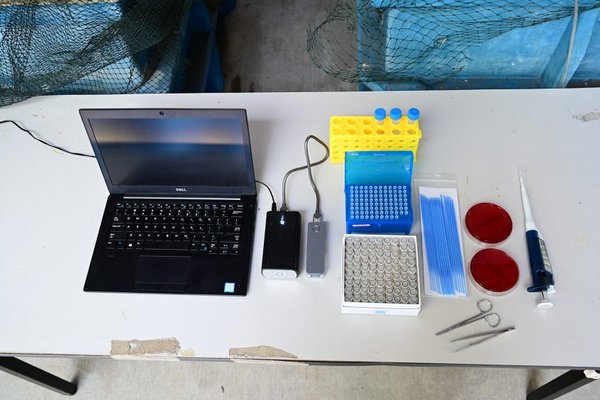- Share this article
- Subscribe to our newsletter
Rapid genomic detection to control disease outbreaks in fish farming
A team of researchers from Malaysia, Australia, New Zealand, Thailand and the United Kingdom are harnessing the power of genome sequencing to help Aquaculture farmers manage fish diseases. Until recently, this had not been possible owing to the costly technology involved and the amount of time and coordination between different specialist labs the genome sequencing process required, explained WorldFish, an international research centre based in Penang/Malaysia, in late March 2020.
But this changed with the invention of MinION, developed by the enterprise Oxford Nanopore Technologies (Oxford/United Kingdom). A small and easy to use USB device now makes the genomic sequencing cheaper and faster.
The Rapid Genomics Sequencing team of WorldFish scientists are now developing a cloud-based database to get high-resolution information from raw nanopore sequences, allowing them to track outbreaks in close to real-time. The information they generate will then be accessed in a user-friendly format via a smartphone, enabling aquaculture inspectors to provide farmers with biosecurity advice and management plans in the palm of their hands.
It will also inform local manufacturers what to put into custom vaccines and which farms need it. With real-time data accurately identifying what is killing the fish, local universities and start-ups will be able to produce simple vaccines for aquaculture health practitioners to inoculate new stocks of fish before dissemination onto farms.
A portable Lab-in-a-Backpack
In a demonstration at the WorldFish office in Penang/Malaysia, the scientific team created a mock-up scenario of how this portable Lab-in-a-Backpack system works. If a fish farmer experiences a disease outbreak on his farm, local aquaculture inspectors can collect samples from diseased fish and send them to a nearby lab where trained operators will be able to process them for whole-genome sequencing, with identification and typing of a bacterial pathogen taking just a few hours.
“Current diagnosis-by-sequencing workflows employ a range of different methods for DNA extraction, sequencing and analysis, and many labs tend to curate their own reference sequence databases in-house,” said Dr Shaun Wilkinson of Wilderlab New Zealand, presenting the MinION device. “This makes it difficult to compare results between laboratories and limits our ability to interpret infection dynamics in a timely manner. Our team is developing a simple and reliable surveillance workflow in which pathogen sequence data is generated on the MinION device and identified in real-time using an intuitive web application. Behind this interface sits a powerful learning algorithm and gold-standard reference sequence database that is continually updated as emergent pathogens are identified,” Wilkinson explained.
Tracing of pathogens by molecular epidemiology
Tracing of pathogens by molecular epidemiology is extremely powerful. It reveals the fine variations between strains of a particular group of bacteria, which helps biosecurity officials to trace the origin of infection and warn farmers or breeders of any problems before moving animals further between regions or countries. For example, a bug’s DNA might show that the strain is new to the fish in country A, but caused an outbreak in a nearby country B a few months earlier.
“Rapid genome sequencing provides all of the information we need to make informed decisions on disease control without the need for pathogen-specific tests and tools that might be very expensive,” said Dr Andrew Barnes of The University of Queensland (UQ), who is part of the team behind the WorldFish-led proposal.
The research team are sharing and demonstrating their portable Lab-in-a-backpack system with other researchers in Asia and Africa to make rapid genomic sequencing of aquaculture pathogens gradually available.
Ultimately, this innovation will enable fish farmers and aquaculture enterprises to track and deal with fish disease in real-time, and thus minimise potential loss of food, incomes and sustainable business.
(WorldFish/wi)
Read the full article on the World Fish Website
More information: Oxford Nanopore Technologies, Oxford, United Kingdom:





Add a comment
Be the First to Comment